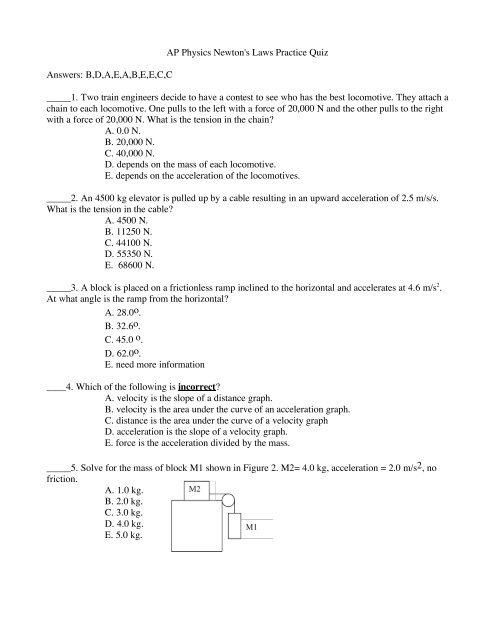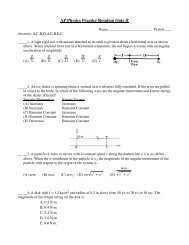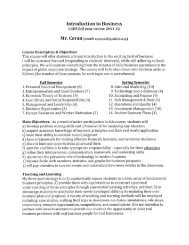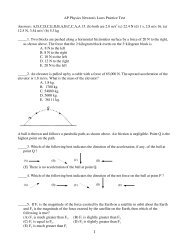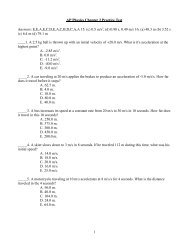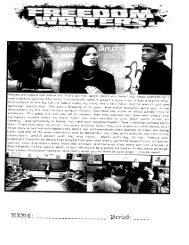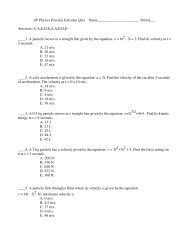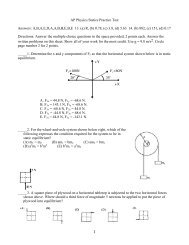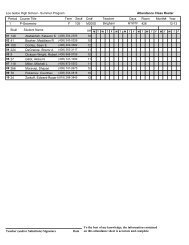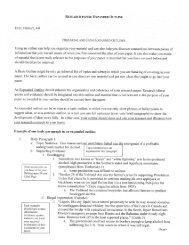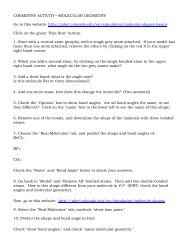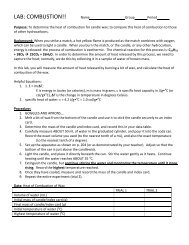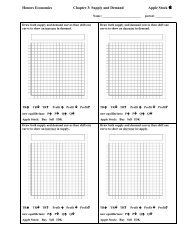AP Physics Newton's Laws Practice Quiz Answers
AP Physics Newton's Laws Practice Quiz Answers
AP Physics Newton's Laws Practice Quiz Answers
You also want an ePaper? Increase the reach of your titles
YUMPU automatically turns print PDFs into web optimized ePapers that Google loves.
<strong>Answers</strong>: B,D,A,E,A,B,E,E,C,C<br />
<strong>AP</strong> <strong>Physics</strong> <strong>Newton's</strong> <strong>Laws</strong> <strong>Practice</strong> <strong>Quiz</strong><br />
_____1. Two train engineers decide to have a contest to see who has the best locomotive. They attach a<br />
chain to each locomotive. One pulls to the left with a force of 20,000 N and the other pulls to the right<br />
with a force of 20,000 N. What is the tension in the chain?<br />
A. 0.0 N.<br />
B. 20,000 N.<br />
C. 40,000 N.<br />
D. depends on the mass of each locomotive.<br />
E. depends on the acceleration of the locomotives.<br />
_____2. An 4500 kg elevator is pulled up by a cable resulting in an upward acceleration of 2.5 m/s/s.<br />
What is the tension in the cable?<br />
A. 4500 N.<br />
B. 11250 N.<br />
C. 44100 N.<br />
D. 55350 N.<br />
E. 68600 N.<br />
_____3. A block is placed on a frictionless ramp inclined to the horizontal and accelerates at 4.6 m/s 2 .<br />
At what angle is the ramp from the horizontal?<br />
A. 28.0 o .<br />
B. 32.6 o .<br />
C. 45.0 o .<br />
D. 62.0 o .<br />
E. need more information<br />
____4. Which of the following is incorrect?<br />
A. velocity is the slope of a distance graph.<br />
B. velocity is the area under the curve of an acceleration graph.<br />
C. distance is the area under the curve of a velocity graph<br />
D. acceleration is the slope of a velocity graph.<br />
E. force is the acceleration divided by the mass.<br />
_____5. Solve for the mass of block M1 shown in Figure 2. M2= 4.0 kg, acceleration = 2.0 m/s 2 , no<br />
friction.<br />
A. 1.0 kg.<br />
B. 2.0 kg.<br />
C. 3.0 kg.<br />
D. 4.0 kg.<br />
E. 5.0 kg.
_____6. What is the weight of a 90 kg <strong>Physics</strong> teacher?<br />
A. 90 kg.<br />
B. 882 N.<br />
C. 198 N.<br />
D. 90 N.<br />
E. 9.8 N.<br />
_____7. A 0.3 kg hockey puck slides horizontally to the right on frictionless ice at a constant 20 m/s.<br />
What is the net force on the puck?<br />
A. 6.0 N to the right<br />
B. 6.0 N to the left<br />
C. 3.0 N to the right<br />
D. 3.0 N to the left<br />
E. 0.0 N<br />
_____8. A train going at constant velocity hits a cow on the tracks. Which of the following is correct?<br />
A. The cow experienced the greatest force.<br />
B. The train experienced the smallest force.<br />
C. The train had the greatest acceleration.<br />
D. All of the above.<br />
E. None of the above.<br />
_____9. There are two horizontal forces on the 4.0 kg box in the overhead view below but only one is<br />
shown. The box moves strictly along the x axis. If the acceleration is 15 m/s/s to the right, what is the<br />
magnitude and direction of the second force?<br />
A. 20 N to the right.<br />
B. 20 N to the left.<br />
C. 40 N to the right.<br />
D. 40 N to the left.<br />
E. 0 N.<br />
_____10. When the frictionless system shown above is accelerated by an applied force of magnitude F,<br />
the tension in the string between the blocks is (A) 2 F (B) F (C) (1/3)F (D) 0.5F<br />
(E) (2/3)F


